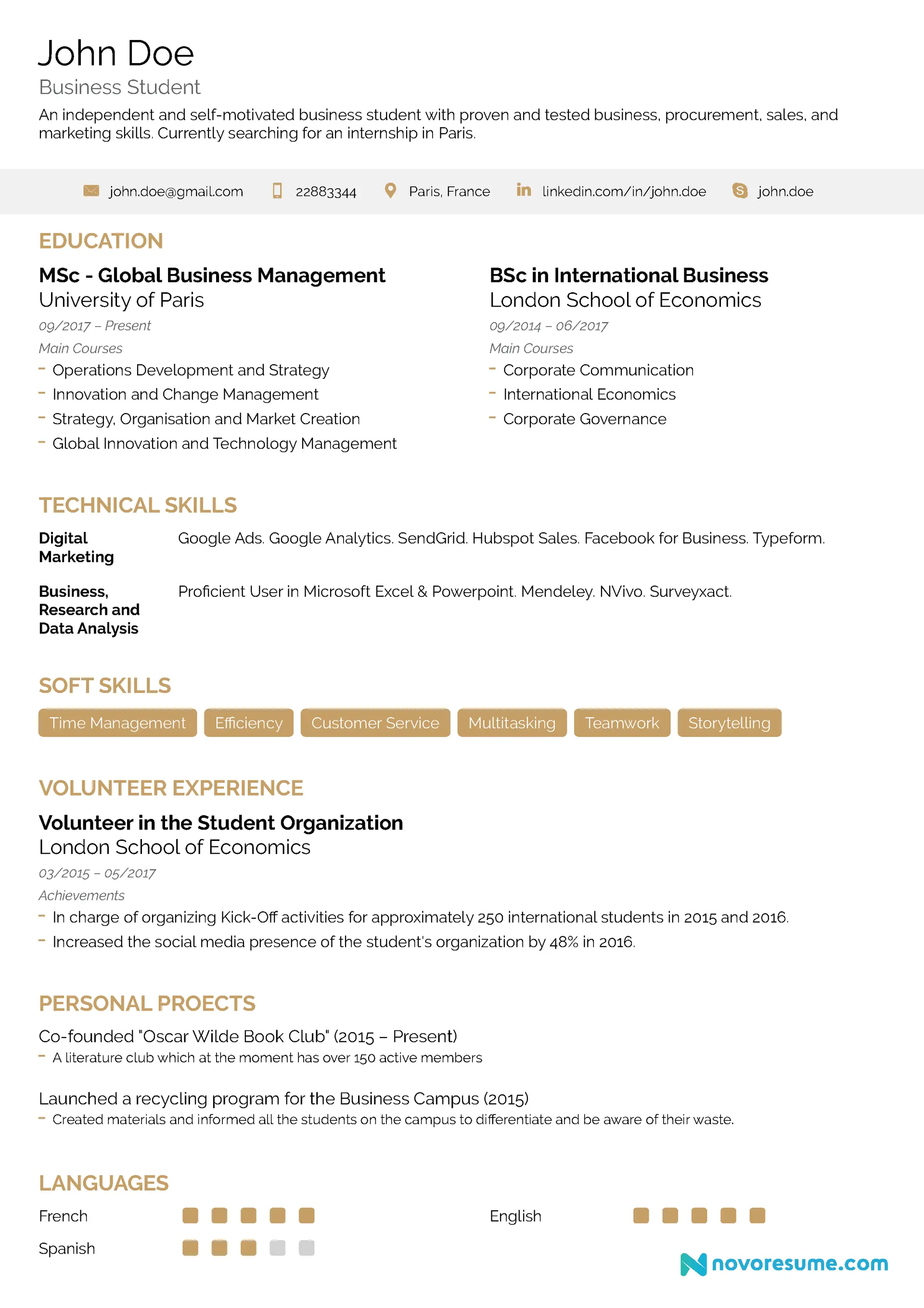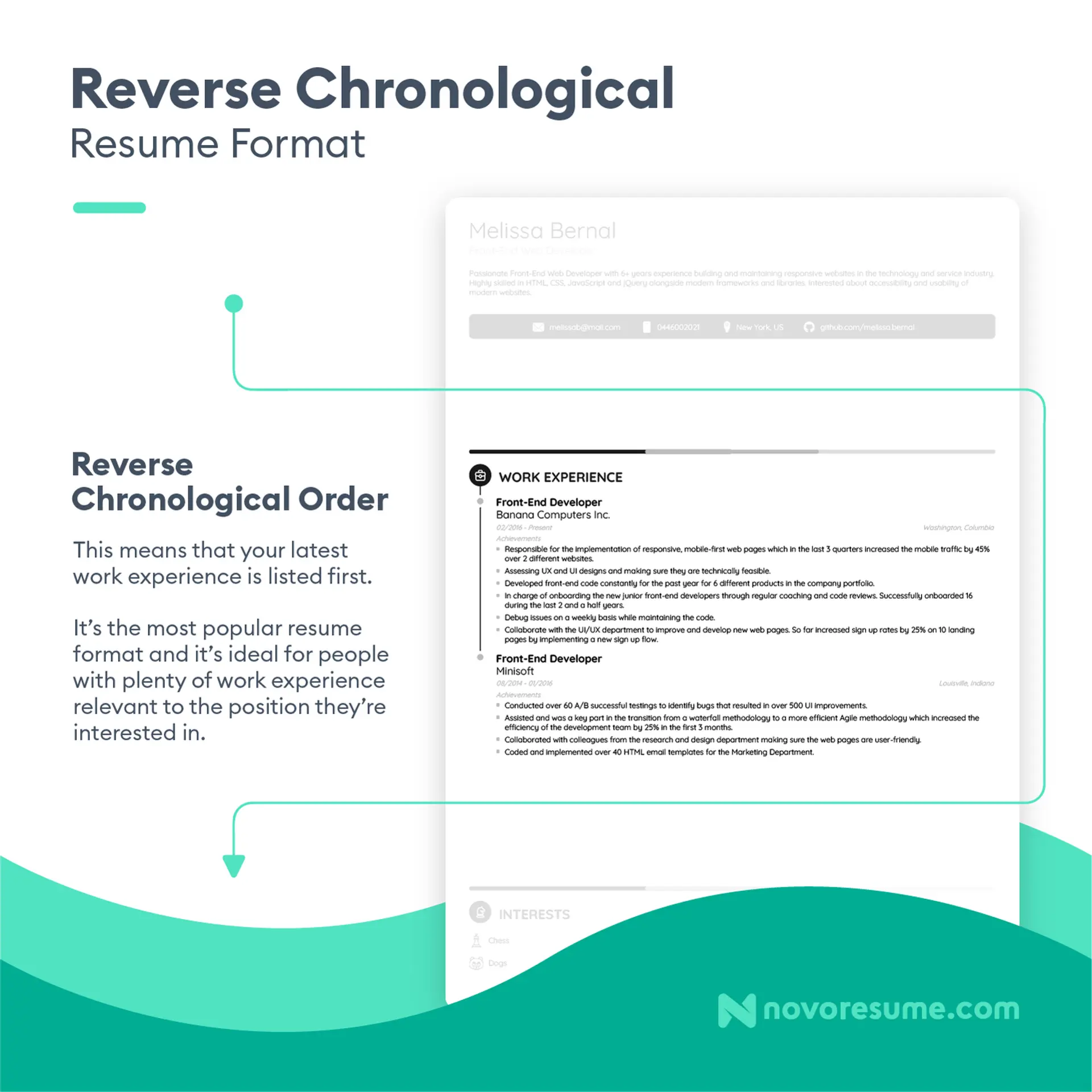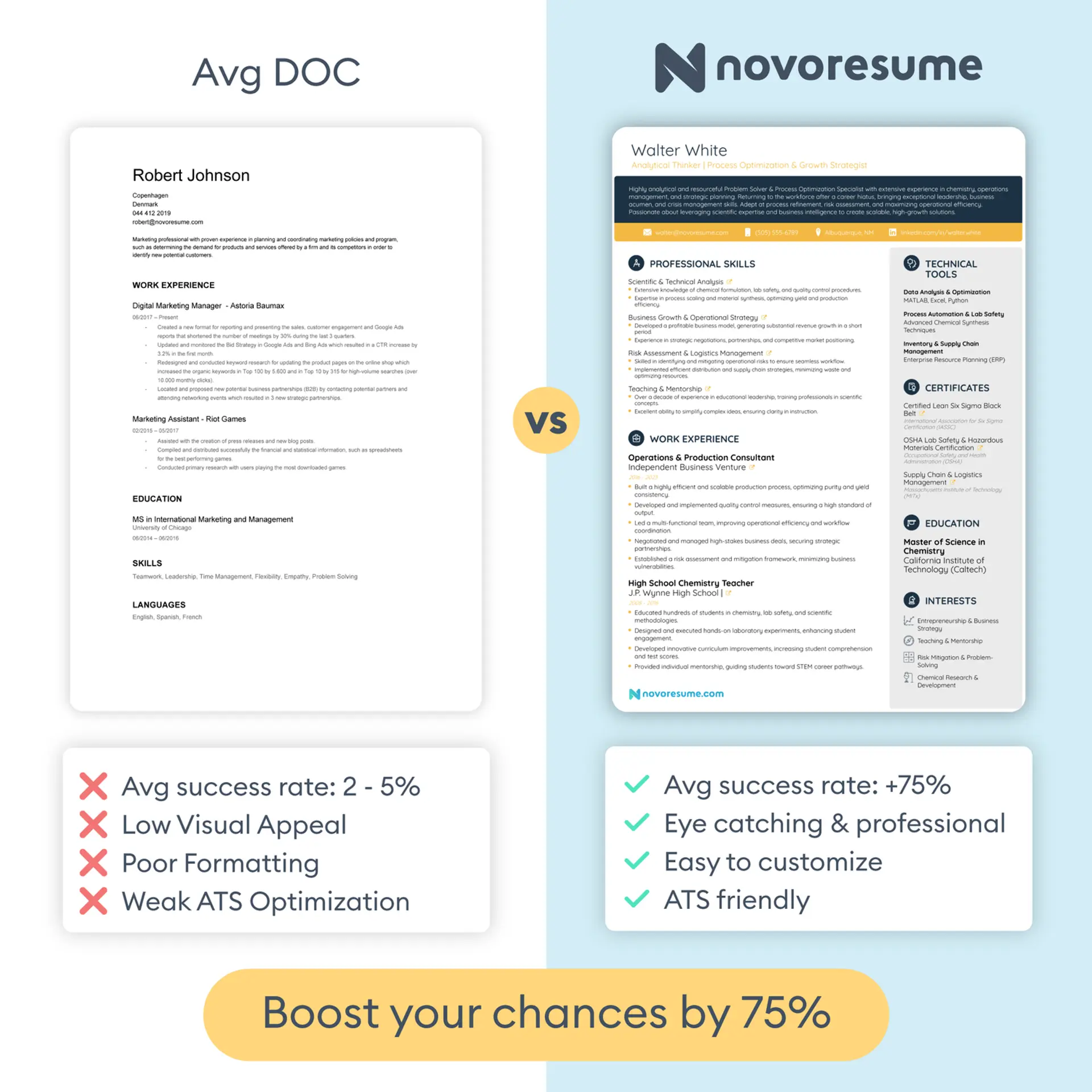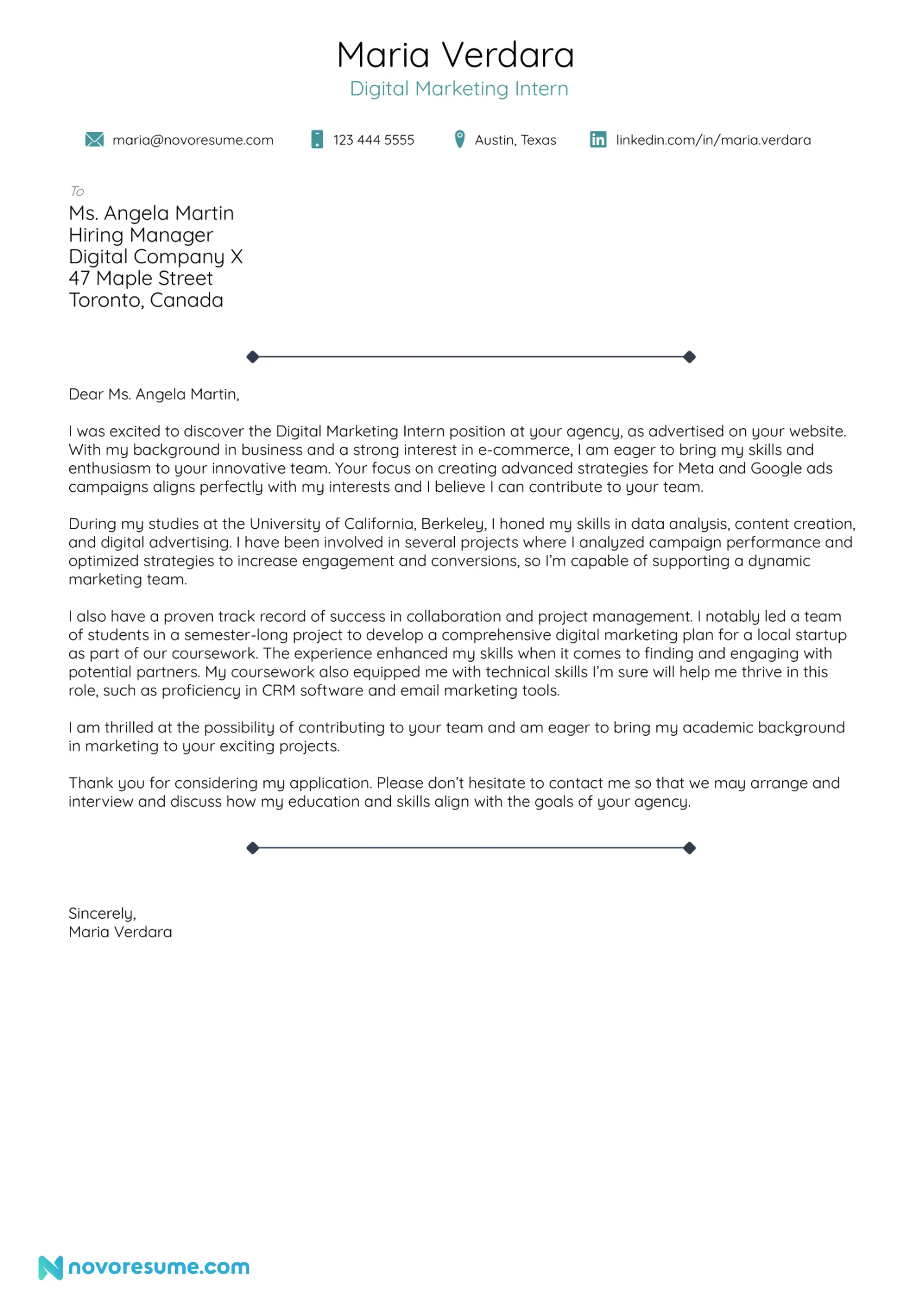
You put in the hours studying, and you're set on a field you want to grow in.
Now, you're eager to jump-start your career with an internship that puts your skills to the test.
But as thrilling as entering the professional world is, creating a resume that reflects your abilities and enthusiasm can make it daunting.
You might find yourself staring at a blank page with no idea where you should start. How can you show the hiring manager that you’re just the right person for this internship?
No need to worry; we're here to help.
In this article, we’re going to show you how to navigate the first steps of your career journey.
We’re going to cover:
- What a Great Internship Resume Looks Like
- 8 Steps to Writing the Perfect Internship Resume
- What to Include in Your Internship Resume
…and more!
Let’s get started.
Internship Resume Example

Now that’s how you write a great resume for a business or marketing internship.
Here’s what it does right:
- Uses a reverse-chronological format. This is the best format to emphasize your most recent experience and achievements, and it’s a favorite for hiring managers around the world.
- Adds relevant contact details. This internship resume example makes sure to include the most necessary contact information, including the candidate's full name, professional email, phone number, Skype username, and a link to their LinkedIn.
- Includes a resume headline. The brief paragraph positioned at the top of the resume can show the hiring manager how the candidate’s education, skills, and motivation make them the right person for the job from the get-go.
- Expands on the education section. Since the candidate is just starting their career journey, their resume focuses more on their education and the relevant courses that show they know about the field they’re aiming for - in this case, business.
- Highlights relevant skills. This internship resume lists several sets of crucial business and marketing skills while keeping the hard skills and soft skills separate.
- Organizes content with bullet points. To keep their resume concise and easy to read, the candidate uses bullet points to list their achievements, courses, and qualifications.
- Leverages optional sections. This internship resume uses sections like volunteer experience, personal projects, and additional languages that show the hiring manager the candidate’s skills and achievements beyond their education.
- Keeps the resume on one page. The candidate makes sure to keep their resume under one page long and only list relevant information that shows the hiring manager why they’re perfect for the internship.
9 Steps for the Perfect Animator Resume
You saw for yourself what an internship-worthy resume looks like. Now, it’s time to write your own!
We’ve broken the process down into easy-to-follow steps, starting with:
#1. Choose the Best Format
Before you can begin writing your resume, you need to choose a format to work with.
There are three main resume formats you can choose from:
- Reverse-chronological (also called chronological)
- Functional (also called skill-based)
- Combination (a mix of the chronological and functional formats)
For 99% of candidates, we recommend sticking with the reverse-chronological resume format for your internship resume.
The reverse-chronological format is by far the most popular of all three, so it’s what hiring managers expect you to use.
Not to mention, this format highlights your most recent achievements first, so it’s the perfect choice to show the hiring manager what you’ve been up to lately.
Here’s an example of the reverse-chronological resume format:

#2. Tweak the Layout
Once you’ve decided on a format for your resume, it’s time to focus on your resume layout.
After all, before the hiring manager reads your resume, they’re going to look at it. And if what they see is a messy, cluttered document, or a half-empty page, they might decide it’s not worth reading at all.
So, let’s look at some resume layout tips you should follow to make sure the hiring manager likes what they see:
- Adjust the margins. Ideally, the margins should be one inch on all sides of the page. This way, your resume will look well-organized, not cluttered or empty.
- Set the line spacing. We recommend you stick to the standard line spacing, which is 1.0 between text and 1.15 between double lines and after subheadings.
- Choose a professional font. You want your resume font to be easy to read but not overused. Avoid fonts like Times New Roman and Comic Sans, and instead, use something like Lora, Roboto, Ubuntu, etc.
- Stick to one page. Hiring managers go through hundreds of resumes every day, so you want to make sure yours grabs their attention from the start. Keep it to one page of only relevant information.
- Save it to the correct file format. Unless the employer specifically requests otherwise, you should save your resume as a PDF file. As a PDF, your resume’s layout is going to stay the same across any device or operating system the hiring manager might use to open it.
Or Use a Professional Resume Template Instead
Creating a perfect internship resume from scratch takes time.
You have to work on the layout, adjust the margins, and make sure the font is set to the right size, all while minding that nothing spills over to page two.
Why not skip all the hassle?
Just use any of our free, tried-and-tested resume templates.
Each resume template is created in close collaboration with designers and leading HR pros, so your resume can be professional, easy to read, ATS-friendly, and stylish.
Take a look at how one of our templates looks compared to a standard text editor resume:

#3. Add Your Contact Information
Once you’ve got your resume’s layout in order, it’s time to start filling in its contents.
This is where your contact information comes in.
All you need to do in this section is make sure everything is factually correct and professional. You don’t want to miss any interview opportunities because of a typo in your email or phone number.
Here’s what this section should include:
- Full Name (e.g., John Doe)
- Professional Title. You can match this to the exact role you're after (e.g., Marketing Intern or Business Communications Intern) or with what you’re currently doing (e.g., Business Student).
- Phone Number. Include the country code if you're applying for an opportunity outside your home country. (e.g., the area code in the USA is +1 but for France, it’s +33.)
- Email Address. Use an email that's based on your name, and avoid any nicknames or quirky jokes. (e.g., johndoe@novoresume.com, not johntheman997@email.com)
- Links. You can include a link to your LinkedIn profile or an online portfolio where you can show any relevant projects or coursework.
- Location. The city and state/country where you’re based are enough information. If you’re open to working remotely or if you're prepared to move for the internship, mention that here. (e.g., You can add “Based in Sweden but willing to relocate to Krakow for the position.” at the end of your resume headline.)
Correct Example:
John DoeBusiness Student+1 228-833-4411john.doe@novoresume.comlinkedin.com/in/john.doeParis, FranceIncorrect Example:
Johnny D.Le Best Intern0228833441johnnydoesntknow@email.comEurope
#4. Write a Headline
On average, hiring managers spend less than six seconds skimming a resume before deciding if it’s worth reading.
This is where your resume headline comes in.
This is a paragraph that acts as a summary of your resume’s highlights. So, the more engaging this paragraph is, the better your chances of getting the hiring manager’s attention from the start.
There are two ways you can go about this:
- Resume Summary. A resume summary is a three to four-sentence paragraph that briefly highlights your experience and achievements. This is a great choice if you already have some relevant experience in the field you’re aiming for.
- Resume Objective. If you’re new to the workforce, a resume objective is a great choice. This provides an overview of your career goals and aspirations, as well as any relevant skills or qualifications.
So, what do these paragraphs look like in action?
Let’s start with the resume summary.
Internship Resume Summary Example:
Enthusiastic marketing intern with hands-on experience in content creation and social media management, looking to leverage skills at Digital Agency X. Successfully increased social media engagement by 30% at Company Y by implementing targeted content strategies. Proficient in Hootsuite and Google Analytics.
That’s pretty good! It tells the hiring manager what the candidate’s done, what they’re good at, and why they should keep reading.
Now, let’s look at the resume objective:
Internship Resume Objective Example:
Detail-oriented economics student seeking an internship position at Financial Firm Y. Ready to apply academic knowledge to real-world financial analysis and eager to gain practical experience. Strong foundation in statistical analysis and econometric modeling from coursework and university projects. Proficient in Stata and Excel.
As you can see, even without any work experience, done right, your resume objective can make you stand out from the crowd.
#5. Focus on Your Work Experience
By far the most important section of your resume is your work experience.
However, if you’re applying for an internship, you probably don’t have a lot of work experience.
Here’s the good news - hiring managers don’t expect you to. Internships are usually aimed at students and entry-level workers who are just getting started in a field, so you don’t have to dazzle anyone with tons of relevant work experience.
That being said, if you do have some work experience, you need to know how to format the section properly.
Here are some tips to keep in mind:
- Use reverse chronological order. Start with your most recent experience and go backward.
- Use the right job title. If your last job had a quirky title like 'Digital Wizard', just use a straightforward job title like 'Digital Marketing Assistant' instead.
- Include company details. Add the name and location of your previous employers. If they’re a small business, you can also add a line describing what the company did.
- Specify the period. Use a month/year format throughout your resume to keep things consistent. There’s usually no need to specify exact dates.
- Describe your responsibilities and achievements. Use bullet points instead of paragraphs to list any relevant responsibilities and achievements. We recommend using up to six bullet points for your most recent role and fewer as you work your way back.
Those are the basics behind formatting the work experience on your internship resume.
But, if you want to stand out from the crowd, you want to go beyond the basics and make this section pop.
Here are a few more tips to take your work experience to the next level:
- Tailor to the internship you're applying for. Only include your most recent or relevant experiences. For example, don’t mention a part-time job as a pizza delivery person if you’re applying for an internship as a writer.
- Focus on achievements. Daily responsibilities don’t tell the employer anything new, but achievements can show your potential value. For example, saying you “Helped in social media campaigns” is fine, but when you “Increased social media engagement by 20% through targeted campaigns” the hiring manager can see the results.
- Quantify your achievements. Whenever possible, use numbers to show the impact you made. (e.g., “Helped increase newsletter subscribers by 300 over three months”)
- Use strong action verbs. Avoid passive phrases like “was responsible for” or “helped with” and replace them with action verbs like 'organized,' 'developed,' 'implemented,' or 'enhanced' to show initiative.
So, let’s see what these tips apply in real life:
Internship Resume Work Experience Example:
Business InternConsulting Firm Y06/2023 - 12/2023- Completed market research and data analysis projects under tight deadlines.
- Supported the implementation of a new CRM tool that improved the efficiency of the team's data management.
- Helped onboard and train new interns, making sure they were familiar with office procedures and project tools.
- Participated in monthly client meetings and provided support in preparing presentation materials.
- Contributed to a major consulting project by collecting and analyzing customer feedback, which helped enhance the final report's insights.
- Recognized with a departmental commendation for teamwork and dedication during the quarterly review.
#6. Keep Your Education Section Relevant
Usually, we recommend keeping the education section on your resume short and sweet.
However, if you’re applying for an internship, there are a few exceptions to the rule, including:
- If you don’t have any work experience.
- If your education is directly related to the field you want to intern in.
- If you’re applying for an internship while you’re currently a student.
- If you’re in the midst of a career change and your education is more relevant than your work experience.
In each of these cases, we recommend that you expand on your education a bit more. This means you can list any relevant courses, awards, and honors – and even your GPA if it’s good.
Here’s how to list the education details on your resume:
- Degree Name. E.g. Creative Writing and Journalism
- University Name. E.g. Du Monfort University
- Location (optional). E.g. Leicester, UK
- Years Attended. E.g. 2020 - 2024
Here’s an example of how it could look on your resume:
Internship Resume Education Example:
BS in Business Administration, Minor in MarketingUniversity of MiamiMiami, Florida, USA09/2019 - 05/2023- Courses: Strategic Management, Consumer Behavior, Digital Marketing Strategies, Financial Accounting
- Awards and Honors: Dean’s List (Fall 2020, Spring 2021), Business Leadership Award 2022
- GPA: 3.75
#7. Include In-Demand Soft and Hard Skills
Another important section on your internship resume is the skills section.
In fact, over 40% of hiring managers look at the skills listed on your resume first.
Your skills tell the hiring manager about what you can do, which tools you’re proficient with, and how much training you might need.
So, this section is a great way to show why you are a standout candidate for the internship you want.
The way to do that, though, is not by listing every skill under the sun. Instead, you want to focus on the ones that are most relevant for the internship you're applying for.
For example, if you're applying for a marketing internship, you probably don’t need to talk about your advanced Excel skills. Instead, focus on your experience with social media management tools, content creation software like Adobe Photoshop, or even data analysis tools that are relevant to marketing.
Here are a few tips on how to get this section just right:
- Highlight what the company is looking for. Carefully read the job description and look for any of the specific skills it mentions. If you have any of those skills, make sure to include them on your resume.
- Keep up with industry trends. Being an intern often means you get to learn new things, and that includes being at the cutting edge of new techniques and tools in your field. Stay updated on what the most sought-after skills in your field are, and include any that you've learned.
- Separate your soft and hard skills. Organize your skills into categories. For example, list soft skills like communication, teamwork, and problem-solving separately from hard skills like software proficiency or technical know-how. This can help hiring managers quickly find the exact skills they’re looking for.
There are tons of skills out there you might need to list on your resume, depending on your field. If you need help with where to start, check out our article with over 400 skills to put on your resume.
#8. Use Optional Resume Sections
Once you’ve gone through all these section, you might find that your resume still looks empty.
It happens, especially if you don’t have a lot of work experience. Thankfully, there are a lot of other sections you can leverage to fill up your resume.
Some sections you can use include:
- Certifications. Keeping up with the latest industry trends and enhancing your skills shows your commitment to your career development. Here, you can include any relevant certifications or training you've completed outside of your formal education.
- Projects. List any significant university assignments or independent projects you were part of. Hiring managers love candidates who do cool stuff in their free time since it shows that you're enthusiastic and proactive about your field.
- Languages. Lots of businesses operate on a global scale and have diverse teams. Being proficient in multiple languages can make you a standout candidate for roles that might need collaboration across different countries or cultures.
- Hobbies and interests. Take a moment to research the culture of the company you're applying to. Some employers appreciate a personal touch on resumes, like hobbies and interests, because they can reveal more about who you are and how well you’d fit in as part of the team.
💡
Quick Tip
Some optional sections, such as volunteer experience or extracurricular activities, can be formatted the same way as your work experience section. Use these sections to show off your skills and experience!
Let’s look at an example of optional resume sections in action:
Internship Resume Optional Sections Example:
EXTRACURRICULAR EXPERIENCEStudent Council Member, University Web CommitteeUniversity of California, San Diego09/2020 - 06/2023- Directed the redesign of the university’s student portal, enhancing user interface and experience, which increased daily student engagement by 40%.
- Organized and led usability testing sessions to gather student feedback, utilizing the insights to optimize navigation and content accessibility on the university website.
- Served as the student council's representative to the university's IT department, making sure student needs and feedback were central to ongoing web development projects.
CERTIFICATIONS- Adobe XD: User Experience Design
Udemy, 2022 - Practical UI Design Fundamentals
Coursera, 2023
#9. Include a Cover Letter
Just because your internship resume is ready doesn’t mean you’re done.
Now, we know - odds are, you aren’t a writer, and writing a cover letter is the last thing you want to do.
But cover letters are still crucial for a successful application.
When you write a cover letter, you’re showing the hiring manager that you’re genuinely interested in the job and that you’re ready to go the extra mile to prove it. You’re not just sending out your resume left and right - you put in real effort.
So, including a cover letter with your internship resume can seriously increase your odds of getting an interview and landing the internship you want.
And we’re here with the right cover letter tips you need to nail it!
First, let’s take a look at what a great internship cover letter looks like:

Now, let’s look at the structure of a cover letter:

- Include your details in the header. At the very top of your cover letter, list your full name, contact information, and the job title you are applying for, just like in your resume.
- Personalize the greeting. Research the company to find out the name of the hiring manager or the department you’re applying to. This personal touch shows you’ve made an effort and helps your application stand out.
- Start off strong. Your opening paragraph should be concise and capture the hiring manager’s attention. Highlight a few of your key achievements or qualifications to make a memorable introduction.
- Expand in the body. The main section of your cover letter should delve into the details. Discuss aspects of your experience and skills that are relevant to the job, including anything you couldn’t cover in your resume. Take the time to explain why you’re a good fit for the role and the company based on the skills and experience you talk about.
- Conclude it appropriately. End your cover letter with a call to action, and express your excitement to discuss how you can contribute to the company’s goals. Remember to close with a polite closing line, like ‘Best regards’ or ‘Sincerely’.
Key Takeaways
You’ve made it to the end of our article!
If you applied everything we talked about here, we’re sure you’re going to land that internship in no time.
Now, before you go, let’s recap what we mentioned so far:
- You need the right formatting and layout for your internship resume. We recommend stick to a reverse-chronological resume format, and applying the standard practices to make sure your layout stays tidy and professional.
- Your resume only has a few seconds to grab the hiring manager’s attention, so you should write a brief paragraph in your resume header. Depending on how experienced you are, this can be either a resume summary or a resume objective.
- When it’s time to describe your work experience, focus on your achievements more than your day-to-day responsibilities. This can show the hiring manager how much you can do for their company once you’re hired, and it’s a lot more impressive than everyday tasks.
- If you’re applying for an internship, odds are you don’t have a lot of work experience, and that’s okay. You can focus on other aspects, like your education, your personal projects, or any relevant volunteer experience.
- Take the time to research what skills are in demand for the field you’re applying to. Then, list them in separate sections for soft and hard skills.
- Make sure to write a cover letter to match your resume. Try using one of our cover letter templates to create a matching application in minutes.
